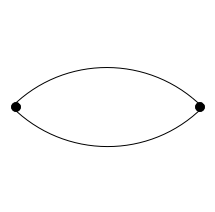
Back Arestes múltiples Catalan Mehrfachkante German Aristas múltiples Spanish Aresta múltipla Portuguese Кратные рёбра Russian பல்விளிம்புகள் (கோட்டுருவியல்) Tamil Кратні ребра Ukrainian 重边 Chinese

In graph theory, multiple edges (also called parallel edges or a multi-edge), are, in an undirected graph, two or more edges that are incident to the same two vertices, or in a directed graph, two or more edges with both the same tail vertex and the same head vertex. A simple graph has no multiple edges and no loops.
Depending on the context, a graph may be defined so as to either allow or disallow the presence of multiple edges (often in concert with allowing or disallowing loops):
- Where graphs are defined so as to allow multiple edges and loops, a graph without loops or multiple edges is often distinguished from other graphs by calling it a simple graph.[1]
- Where graphs are defined so as to disallow multiple edges and loops, a multigraph or a pseudograph is often defined to mean a "graph" which can have multiple edges.[2]
Multiple edges are, for example, useful in the consideration of electrical networks, from a graph theoretical point of view.[3] Additionally, they constitute the core differentiating feature of multidimensional networks.
A planar graph remains planar if an edge is added between two vertices already joined by an edge; thus, adding multiple edges preserves planarity.[4]
A dipole graph is a graph with two vertices, in which all edges are parallel to each other.
© MMXXIII Rich X Search. We shall prevail. All rights reserved. Rich X Search